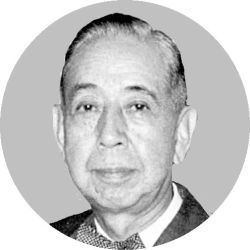Kishi pushed U.S. to set deadline for Okinawa’s return at 1957 summit

Former Prime Minister Nobusuke Kishi
October 31, 2013 Ryukyu Shimpo
Diplomatic documents declassified on October 30 revealed that at his meeting with President Dwight D. Eisenhower in Washington, D.C., on June 1957, then Prime Minister Nobusuke Kishi was to request that administrative rights over Okinawa to be returned to Japan “in ten years.” The documents indicate that Kishi put Okinawa’s return on the summit meeting agenda in addition to talks on revising the Japan-U.S. Security Treaty. These newly declassified documents on Okinawa’s reversion show that Japan estimated that as of 1969 $20 million would be required to cover the relocation for the relay station of the Voice of America (VOA). This became a major issue in later years because in a secret agreement Japan agreed to shoulder the burden of cost to move the station.
Kishi met with President Eisenhower and Secretary of State John Foster Dulles during his visit to Washington, D.C. A memo dated April 1, 1957, created by the Japanese government in the lead up to the summit meeting pointed out that Okinawa’s reversion was a key factor hindering the development of cooperation between the United States and Japan. The memo states that Japan was to put forward a suggestion to resolve the territorial issue, and that based on Article 3 of Treaty of Peace with Japan (San Francisco Peace Treaty), the United States would give up all rights and interests in ten years. There was a handwritten correction of the words “seven years” to read “ten years.”
However, Kishi made no reference to a specific deadline in the talks. The former prime minister indicated that he understood that the U.S. military presence in Okinawa was necessary to ensure security in the Far East, but stated, “I find it difficult to accept the view that we must totally leave (Okinawa’s) administration” to the United States. Kishi suggested that President Eisenhower set a deadline to return Okinawa, saying, (because the U.S. administration of Okinawa remained open-ended) “The Japanese people can’t help feeling uneasy about American intentions.” Eisenhower said that Okinawa would be needed to respond quickly in the case of invasion, suggesting that its return was not an option at that stage.
The Ministry of Foreign Affairs has released 92 books, including 25 books on the reversion of Okinawa. They include records of Japan-U.S. negotiations on the Self-Defense Forces deployment to Okinawa and Operation Red Hat in which poison gas stored in Okinawa was removed to the U.S. territory Johnston Island.
Glossary
Declassified diplomatic documents
In 1976, the Ministry of Foreign Affairs began to declassify some diplomatic documents created more than 30 years earlier. However, many documents have remained classified because their declassification has been left up to the judgment of each department. The previous Democratic Party of Japan (DPJ)-led administration introduced a system in which as a general rule documents older than 30 years will be declassified. This was triggered by the investigation of the U.S.-Japan secret agreement on nuclear weapons. The Liberal-Democratic Party, which returned to power at the end of last year, has also adhered to this policy. The documents will be available for viewing at the Diplomatic Archives in Tokyo after the procedures and declassification review have been completed.
(English translation by T&CT, Mark Ealey)
Previous Article:First generation Okinawan Bolivian couple returns to their homeland
Next Article:Over 30,000 grey-faced buzzards fly to Miyako
[Similar Articles]
- Removal of nuclear weapons from Okinawa delayed its reversion to Japan
- US shows a copy of the Ryukyu-US Treaty and letters by Commodore Perry
- Remembering History and Bonds of Friendship, Okinawa and Yoron Meet at Sea 70 Years After the Day of Insult (Video Included)
- Political journalistTakano: “The presence of U.S. Marines on Okinawa is unnecessary”
- Governor Onaga to visit to US at end of January, making appeal to incoming administration for Henoko issue

 Webcam(Kokusai Street)
Webcam(Kokusai Street)


